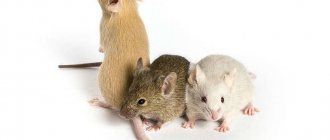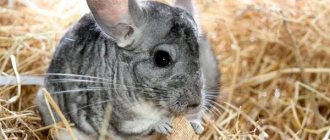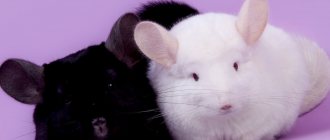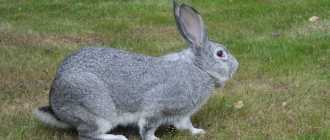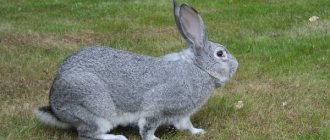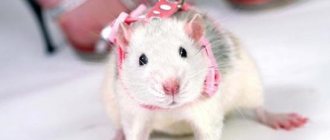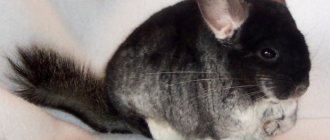- Wild animals
- >>
- Mammals
For many, such an interesting animal as the chinchilla is not at all a rarity; it has long become a common pet. This is no wonder, because these cute fluffy rodents are very attractive and cute. But chinchillas living in the wild are not easy to meet, because there are very few of these animals left, and they live only on one South American continent.
Origin of the species and description
Photo: Chinchilla
It is still unknown who the ancestor of the chinchilla is. Carrying out archaeological excavations in the Cordillera, scientists extracted from the bowels of the earth prehistoric fossils, which in their structure are very similar to chinchillas, only much larger in size. This animal, according to experts, lived forty thousand years ago, so the chinchilla genus is quite ancient. The Incas, many centuries ago, depicted chinchillas on rocks; this painting has survived to this day.
The Incas made various items of clothing from the soft skins of chinchillas, but among the Indians they were far from the first who were so attracted to the fur of rodents. The first who began to wear clothes made from chinchilla skins were the Indians from the Chyncha tribe. It is believed that the chinchilla got its name from them, because the word “chinchilla” itself is consonant with the name of an Indian tribe.
Video: Chinchilla
For the Incas, the value of chinchilla fur was very high; they maintained constant control over their production so as not to harm the animal population. But by the end of the 15th century the situation got out of control, because... The Spaniards who arrived on the mainland began a ruthless hunt for helpless rodents, which led to a rapid decrease in their numbers. The authorities of such South American countries as Chile, Bolivia and Argentina have banned the shooting of animals and their export, and introduced severe punishment for illegal hunting.
The chinchilla is a rodent from the chinchilla family of the same name.
These animals have two varieties:
- short-tailed chinchillas (coastal);
- Chinchillas are large, long-tailed (mountain).
Mountain chinchillas live at high altitudes (more than 2 km), their fur is thicker. This species is distinguished by a hump nose, which is designed for inhaling chilly mountain air. The coastal type of chinchillas is much smaller, but the tail and ears are much longer than those of mountain chinchillas. Officially, the short-tailed chinchilla species is believed to have disappeared completely, although local residents say they have been seen in remote mountainous areas of Argentina and Chile.
It is interesting that the first chinchilla farm was organized by the American Mathias Chapman, who brought the animals to the USA. He began to successfully breed chinchillas in order to sell their valuable fur; many then followed in his footsteps, organizing their own farms.
Expenses
1. Buying chinchillas. The price of one individual is about 6-9 thousand rubles. For 3-4 females, one male is needed.
2. Equipment. Acquisition of cells. The maintenance area is required to be small in size. Up to 20 animals can freely fit in an area of 2 square meters.
The cells are placed on top of each other, so little space is required.
A cage of 30x40 cm is enough for one animal. They are made independently, to order, or purchased in stores. The cost of a cage can be from 1500 to 10 thousand rubles.
3. Nutrition. In one month, one individual consumes up to 0.7-1 kg of dry food, at a cost of up to 20 rubles per kilogram. It is possible to prepare food yourself, which will significantly reduce costs (hay, dried dandelion leaves).
Appearance and features
Photo: Long-tailed chinchilla
Long-tailed chinchillas are very small, their body grows no more than 38 cm in length. The length of the tail varies from 10 to 18 cm. Long rounded ears reach 6 cm in height. Compared to the body, the head is quite large, the muzzle is round with cute large black eyes, the pupils of which are located vertically. The animal's whiskers (vibrissae) are long, reaching up to 10 cm; they are necessary for orientation in the dark. The weight of an adult rodent is less than a kilogram (700 – 800 g), the female is larger than the male.
The fur coat of the animals is pleasant, fluffy, soft, with the exception of the tail, which is covered with bristly hairs. The color of the fur is usually gray-blue (ashy), the belly is light milky in color. Other colors can be found, but they are rare.
A chinchilla has only 20 teeth, 16 of them are molars (they continue to grow throughout life). Compared to other numerous rodents, chinchillas can be called long-livers; these cute animals live up to 19 years. The chinchilla's paws are small, the animal has 5 fingers on the front limbs, and four on the hind limbs, but they are much longer. Pushing off with their hind legs, chinchillas perform long, deft jumps. The coordination of the animal can be envied; possessing a highly developed cerebellum, the chinchilla skillfully conquers rocky massifs.
An interesting biological feature of the rodent is its skeleton, which is capable of changing its shape (shrinking) if the situation requires it. At the slightest threat, a chinchilla will easily slip into even a tiny crevice. Also, one of the unique features is that the animal does not have sweat glands, so it does not emit any odor at all.
External description
Fast and fluffy is the most accurate and truthful description of this animal. The chinchilla is related to guinea pigs and porcupines.
With short front legs (which are used to hold food while sitting upright) and long, muscular hind legs, this rodent resembles the long-eared chinchilla rabbits.
Chinchilla hair is about 40 millimeters long with gray, white and black stripes. It may appear bluish or silvery gray. These creatures are fleet-footed. The chinchilla may look bulky, but behind its thick, silky fur hides the physique of an amazingly athletic rodent!
Large black eyes look at the ground and his bushy tail twitches. The short front feet have five toes, and the narrow hind feet have three toes and a vestigial toe with stiff bristles surrounding a small, flat claw. The bristles can help provide traction on any surface. Females are larger than males.
Having a thick coat and not being able to sweat, chinchillas can easily overheat in captivity. Its only cooling mechanism is to pump blood through its large ears, which have less hair.
Where does the chinchilla live?
Photo: Animal chinchilla
As already mentioned, the only continent where chinchillas are permanently registered in the wild is South America, or more precisely, the Andes and Cordillera mountain ranges. Animals are distributed from Argentina to Venezuela. The highlands of the Andes are the element of chinchillas, where they climb to heights of up to 3 km.
Little fluffies live in rather harsh, spartan conditions, where cold winds rage almost all year round; in the summer, the daytime temperature does not exceed 23 degrees plus, and winter frosts drop to -35. Rainfall in this area is very rare, so chinchillas avoid water procedures; they are completely contraindicated for them. After all, once wet, the animal will be chilled to the very bones. Rodents prefer to clean their coats by bathing in sand.
Typically, a chinchilla makes its lair in all sorts of small caves, rocky crevices, and between stones. Occasionally they dig holes in order to hide from various predatory ill-wishers. More often, chinchillas occupy abandoned burrows of other animals to live. In the wild, it is possible to meet a chinchilla with your own eyes only in Chile. In other countries there are so few of them that it is not possible to see rodents. And in Chile their population is under threat.
Is it possible to train a chinchilla to go to the litter tray?
Chinchillas are very smart and learn quickly. It is very easy to train them to go to the litter box: place it in the cage in the place where the animal usually goes to the toilet, you need to remove all the bedding and wipe the floor of the cage with lemon. The chinchilla will immediately understand what needs to be done.
Tray
The second method: at first allow the animal to go to the toilet on the entire bedding at the bottom of the cage, but gradually reducing it every day. When a small patch remains, replace it with a small tray. The main thing is to change the bedding every day so that the cage is always dry.
What does a chinchilla eat?
Photo: Chinchilla animal
The chinchilla's preference is plant food, which in the Andes mountains is quite scarce and monotonous.
The main rodent menu includes:
- herbs;
- small bush growth;
- cactus plants (succulents);
- mosses and lichens.
Animals receive moisture from dew and cactus plants, which are very juicy and fleshy. Chinchillas can eat the bark, rhizomes of plants, their berries, and do not disdain various insects. At home, the chinchilla menu is much more varied and tastier. People buy special grain feeds at pet stores. Animals love to eat not only fresh grass, but also various fruits, berries, and vegetables. Chinchillas will not refuse a crust of bread, dried fruits and nuts. Rodents eat hay in large quantities. The diet of chinchillas is very similar to the diet of hares or guinea pigs.
Under natural conditions, chinchillas do not experience any special problems with the intestines and stomach. Although they eat a large amount of green vegetation, some contain a lot of tannins, which help food to be digested normally. Scientists have noticed that in the mountains, next to chinchillas, chinchilla rats live, which make storage rooms with food in their burrows. Chinchillas also constantly use these reserves, eating the food of their prudent and thrifty neighbors.
The most expensive colors of chinchillas
If an animal has a rare color, this does not mean that it automatically becomes 2-3 times more expensive. For a chinchilla with a rare color to become really valuable, its fur must have:
- Saturated color
- Uniform distribution of color
- Light shine
- Uniform coloring of individual parts. For example, a dark back and a white belly. The border between the two colors should be quite clear.
Dark colored chinchillas are more valued than light colored ones.
Such chinchillas must have a pronounced dark color on top and a light belly, and the boundaries between colors must be respected. If, for example, 3 legs are light and 1 is black, then such a chinchilla is sold at a reduced price, since breeders of rare colors are not interested in it. If a chinchilla is one color and has spots of a different color, then for breeders of rare colors this is a defect. Such chinchillas are no longer used for breeding rare colors; they are usually given to a pet store.
There are exceptions when chinchillas develop stripes, which give them a chic appearance. Then the cost of the animal immediately increases.
If a chinchilla does not have the Ebony gene, i.e. If it doesn't have a white belly, it should have a clear separation between the colors.
Chinchillas that do not have the ebony gene (with a white belly) must have a smooth check and a low color border. It’s good if an animal sitting on 4 legs doesn’t have a visible abdomen. It's not scary if it is visible in the form of a small corner from the back.
An ebony chinchilla with a colored belly is more valuable if the belly has the same color saturation as the back. But if the belly is a little lighter, this is not a defect.
The standard colors are solid chinchillas: dark, white, beige, gray and black. There are many of them and it is very easy to breed, since the offspring usually turn out exactly the same.
The most valued are hybrids, which are very difficult to breed because you need to calculate the result in advance. It is possible that the color will turn out accidentally and the offspring will not have it, then the breeder will bear the risks and will have to sell the chinchillas at a lower price than he expected.
Features of character and lifestyle
Photo: Big chinchilla
Not much is known about the temperament and life activity of chinchillas in natural conditions. Apparently because they are difficult to meet due to their small number. Many observations are made specifically on tamed animals living at home. Chinchillas are collective rodents; they live in packs, in which there are at least five pairs, and sometimes many more. This group life helps them better cope with various dangers and enemies. There is always an individual in the flock that observes the environment while others feed. At the slightest threat, this animal signals to others about the danger by making an unusual whistling sound.
Rodents are most active at dusk, when they emerge from their hiding places to explore areas in search of food. During the day, the animals almost never leave their holes and crevices, resting in them until the evening. Chinchillas' eyes are adapted to the dark and see just fine both at night and during the day. They are helped to navigate in space by their long and very sensitive whiskers, which, like navigators, direct them in the right direction, where food is available. Don’t forget about the big ears, which, like locators, pick up any suspicious sounds. The vestibular apparatus of animals is also well developed, so they easily overcome any mountain peaks and obstacles, moving quickly and deftly.
An interesting and unusual fact is that the head of the chinchilla family is always the female; she is the undisputed leader; it is not for nothing that nature has endowed her with larger dimensions compared to males.
Animals practically never see rain; in the regions where they live, such precipitation is very rare. Chinchillas bathe and clean their fur with volcanic sand, so rodents get rid of not only foreign odors, but also all kinds of parasites that live in their fur. An extraordinary feature of the chinchilla is the ability to shoot out its own fur, like a lizard with its tail. Apparently, this helps them in some situations to escape from predators. The predatory animal grabs the chinchilla’s fur, and a piece of it remains in its teeth, while the rodent runs away.
If we talk about the character of these sweetest creatures, it can be noted that domesticated chinchillas are affectionate and good-natured, and easily make contact with humans. The animal is very smart, it is easy to train it to the tray. Still, you can notice that chinchillas have a freedom-loving and independent disposition; you shouldn’t force the animal to do anything; it may get offended and not communicate. Rodents bite very rarely, only in extreme cases. Of course, each animal is individual, has its own characteristics and habits, and therefore the characters also differ.
Taming and walking
Chinchillas are self-sufficient animals by nature, preferring solitude. They cannot be raised and tamed like dogs or cats, although there are exceptions. Some furry representatives show affection and happily sit in the arms of the owner.
How to tame a pet chinchilla:
- During the first days of a week of living in a new home, the rodent needs to adapt. During this period it is better to leave him alone.
- Starting from the 3rd week, you can begin taming: talk to your pet, try to open the cage and extend your hand to the chinchilla. This may interest her, she will begin to sniff the palm and quietly bite the fingers. Chinchilla bites are absolutely safe and painless.
- When the chinchilla gets used to the owner's hand, it can jump onto the palm. The owner does not need to make sudden movements and try to pull the pet out of the cage. At first, such communication procedures are enough.
- For any success in training, you can reward your chinchilla with a tasty treat.
- When the rodent gets used to the person, you can try to lure him out of the cage and put him in your arms. Prepare a treat for your furry friend in advance. Gently stroke the fur on the neck, ears and chest, encouraging the animal with kind words. Try not to stroke your chinchilla's back or sides; he won't like it.
- Communicate with the chinchilla, calling it by name, let it get used to its nickname.
- Do not pick up your chinchilla against its will. She may get scared and bite or scratch in self-defense. Another fighting technique of this rodent is shooting urine at the enemy.
If a chinchilla finds contact with its owner unpleasant, it will make a dissatisfied noise. At such moments, it is better to leave the rodent alone and postpone all attempts to tame the pet to another time. Let her calm down and get used to attention from people.
Social structure and reproduction
Photo: Chinchilla in nature
So, it was already said earlier that chinchillas are social animals that prefer to live in a group, in which they form their pairs. These rodents are monogamous, their unions are quite strong and long-lasting. The undisputed leading position in the family is occupied by the female. The female is ready for procreation already at six months of age, and males mature longer, becoming sexually mature only by 9 months. Chinchillas give birth several times a year (2 – 3).
The pregnancy period lasts for three and a half months. A pregnant female gains significant weight, and as birth approaches, she generally becomes inactive. Usually only one or two babies are born, very rarely – three. Tiny creatures that are already quite formed and look like their parents are born. From birth, the cubs already have a fluffy coat, sharp teeth and keen, curious eyes; they even know how to move.
Babies weigh from 30 to 70 g, it depends on how many of them were born. After just one week from the moment of birth, babies begin to try plant food, but continue to receive mother's milk until they are two months old. Chinchilla mothers are very caring and affectionate towards their children. These rodents are considered low-bearing, compared to their other relatives. In addition, the birth rate of young females is another 20 percent lower than that of experienced individuals. One chinchilla can usually give birth to up to 3 babies per year.
Secrets of choosing the right chinchilla as a pet
When going for a chinchilla, you need to know how to choose a new pet. We have listed some tips below.
- First of all, you need to evaluate the appearance of the rodent. Chinchillas' fur should be soft, clean, close to the body and free from bald spots. The nose and eyes must be clean. It is better not to buy skinny or overly plump individuals. Be sure to run your hand through the chinchilla's fur in the opposite direction. Any deviations in the form of dried pus, scabs, inflammation, as well as the presence of parasites (ticks, fleas, etc.) indicate poor care and the presence of diseases in the animal.
- Look at the behavior of the animal. The animal must be mobile.
- Listen to the chinchilla's breathing. If you hear wheezing and whistling sounds, refuse to purchase this individual.
Note: in nature, chinchillas live in small families, so it is best to purchase 2 rodents of different sexes at once. If you are not ready to keep 2 animals, then be prepared to pay increased attention to your pet.
Natural enemies of chinchillas
Photo: Female chinchilla
Chinchillas have enough enemies in the wild, because every larger predator is not against eating such a small animal. Scientists single out the fox as the main enemy. This predator is much larger than a chinchilla and is very patient. A fox cannot get a chinchilla out of a narrow crevice or hole, but she can tirelessly wait for her prey at the entrance to her shelter for hours. In the wild, these rodents are saved by their camouflage coloring, excellent reaction speed, speed of movement and their compressible skeleton, thanks to which the rodents will penetrate any narrow gap where predators cannot get through.
In addition to the fox, the enemy of the chinchilla can be an eagle owl, an owl, a tayra, an owl, and a viper. Tyra is the most sophisticated enemy, she is similar to a weasel. This predator, having a resourceful body, can sneak right into a chinchilla’s hole or other shelter, catching the victim by surprise. Feathered predators can catch a chinchilla in an open, unprotected area.
Chinchillas have many ill-wishers, but the most merciless of them is the person who continues to poach, destroying cute little animals for their valuable fur coat.
In addition to all of the above, animals are negatively affected by the deterioration of the ecological situation, which is also associated with human activities.
Here you can name:
- soil contamination with chemical compounds;
- depletion of soil and food supply due to livestock grazing;
- disturbances in the atmosphere due to the release of greenhouse gases.
People sometimes think only about their own benefit and well-being, completely forgetting about their smaller brothers, who need, if not support, then at least human non-interference in their life activities.
Possible diseases
For a number of reasons, your pet chinchilla can get sick. In such cases, the pet will require immediate medical attention. An experienced specialist will conduct a diagnosis and select a treatment course based on special medications intended for rodents.
What diseases can a chinchilla develop:
- Hyperthermia is overheating of the body. This condition occurs if the recommended temperature regime is not observed. The deterioration of the pet’s condition begins already at an ambient temperature of +250C. If the air warms up to 300C, the chinchilla may die suddenly. The main symptoms of hyperthermia: immobility, redness of the tongue, stretching of the body while lying on its side, convulsions. First aid: the cage with the chinchilla needs to be moved to a cool place. To relieve her condition, it is recommended to moisten the outside of her ears and paw pads with cool water. To prevent dehydration, give your chinchilla water to drink.
- Abnormal stools and liquid feces are a fairly common problem in domestic chinchillas that arise as a result of poor quality nutrition or after a change in food. The owner needs to disinfect the cage and review the chinchilla’s diet. To combat loose stools, special medications are used that can be purchased at a veterinary pharmacy.
- Colds - occur due to hypothermia of the animal. For example, if the cage is in a draft or the chinchilla has been in low temperatures for a long time. Main symptoms: runny nose, cough, sneezing, watery eyes, lethargy. Chinchilla colds can be treated with medications prescribed by a veterinarian.
- Ringworm is manifested by hair loss in a certain area of the body. It develops as a result of stress or fear, as well as due to low immunity, unsanitary living conditions, or after contact with an infected pet. It is treated with special ointments as prescribed by a doctor.
In addition to the listed pathologies, the domestic chinchilla can develop diseases of the eyes, ears, digestive organs, reproductive system, and even have a stroke. Proper care and quality nutrition will reduce the risk of developing diseases.
Population and species status
Photo: Chinchilla
As scary as it sounds, the chinchilla population in the wild is in danger of extinction. There is disappointing data that over the past 15 years the animal population has decreased by 90 percent. In 2018, scientists counted only about 42 colonies living on the South American continent. They believe that this number of animals will not be enough for their population to increase in the future.
If you know how much a chinchilla fur coat costs, and this is more than $20,000, then it will become clear why this animal was so mercilessly exterminated. It is also necessary to take into account the fact that for one fur coat you will need at least 100 skins.
Europeans began trading chinchilla skins back in the 19th century. The fact that more than seven million skins were exported from the territory of Chile in the period from 1828 to 1916 is terrifying, and in total, 21 million animals were exported and destroyed. It’s scary to even think about such huge quantities! Measures were taken by the government only in 1898, when a ban on hunting and export was introduced, but apparently it was too late.
Chinchilla health and care
Chinchillas are quite fragile creatures. They may faint if they get scared, and an injured chinchilla will remain stressed for life. They are also prone to depression.
Don't be afraid to let them out of their cage, but it is important to remember that they are very sensitive to drafts, heat, direct sunlight and other sudden changes in temperature.
There are several diseases that chinchillas are susceptible to:
- Malocclusion (misaligned teeth)
- Toxemia (blood poisoning)
- Scurvy (vitamin C deficiency)
- Digestive problems
- Problems during childbirth
- They may also chew their own fur when stressed, malnourished, or due to a hereditary problem.
They will need a fairly large cage with levels that they can go up and down to expend their energy.
Non-toxic twigs and dried flowers will make them very happy, but feed them sparingly because they are essentially sweets for them. Also prepare a food dispenser, bedding, water dispenser, hay and a special box of soil for the chinchilla, as well as a small shelter.
Chinchillas are herbivores, so they eat hay and pellets intended for chinchillas. Since they are high maintenance, you will need to learn how to care for a chinchilla. Therefore, they are not recommended as pets for children.
The fact that how long a chinchilla lives depends on the quality of its existence is entirely your responsibility.
Search for buyers
Who is the target audience for this business?
- The main buyers can be both existing farmers in the fur market and new entrepreneurs who want to form this direction in their own city. The search is carried out by offering products through the website and advertising. Direct commercial offers for the sale of individuals are also appropriate.
- Functioning pet stores selling such animals.
- City residents purchase animals for exotic purposes as a tribute to fashion. Attraction through advertising in the city. The income is the highest.
- Factories for sewing fur products and selling fur directly.
- Cafes, restaurant complexes, sellers of meat products - when selling meat.
Basic costs
1. Premises.
For 250 heads - a space of no more than 30-50 square meters (per 1 sq. m - 12 cells, if arranged vertically).
Options:
- when purchasing premises, the amount is paid one-time;
- when renting - monthly;
- own territories (dacha, private outbuildings) - absolutely free.
2. Purchase of animals - 250 heads (200 females and 50 males) about 1-1.5 million rubles.
3. Feed costs – 50,000 rubles per year.
4. Equipment – cages, accessories. For a wholesale order, the cost will not exceed 100,000 rubles.
5. Staff salary - 100,000 rubles. in year.


